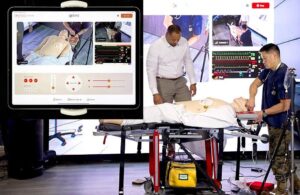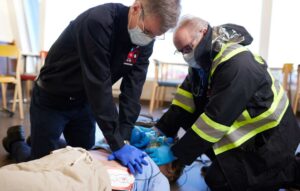EMS Simulator
An EMS Simulator is a medical simulation tool or device used to depict emergency scenarios for education and training purposes. By using an EMS Simulator, trainees and learners alike can practice procedures and treatments that may be involved under high-stress emergency circumstances. Below are the benefits of using EMS Simulators, and a brief outline of just some of the many different types of simulation devices available to Emergency Medical Service educators in the field.
Benefits of EMS Simulator Use
This technology is used to establish a situation or environment which allows learners to experience a representation of a potential real event. This is done for the purpose of practice, learning, evaluation, testing or to gain an understanding of systems or human actions. Through these learning modules, simulation users are granted the ability to make mistakes and receive feedback in real-time. This “practice” helps to avoid potentially life-threatening patient outcomes which may happen when a professional is under-experienced.
Sponsored Content:
Regarding specific emergency practices, EMS Simulators are often used to provide preparation for delivering intranasal naloxone, obtaining IV access, assessing a patient’s airway, learning new equipment and gaining interpersonal skills. Common interpersonal skills necessary for emergency medicine and that can be demonstrated through EMS Simulators include communication during crisis and team-leading abilities. Communication skills such as these can help learners understand complex situations (like disaster management and rare but high-acuity cases), and to prepare for clinical contact with patients.
In addition to teaching and education, EMS Simulators are also extremely useful for assessment and evaluation. Through simulated lesson plans and modules, activities can be developed and designed to assess existing knowledge and evaluate participants’ skill mastery at various levels.
Examples of ways in which simulation can assist with evaluation include conducting baseline assessments of learners at any level or prior to any activity. Varying degrees of learners range from new Emergency Medicine Technicians to intermediate professionals to seasoned Paramedics wishing to advance their skill sets by taking a critical care course.
An EMS simulation assessment can be largely beneficial when determining the completion of coursework or semester knowledge, screening new hires and ensuring adherence to protocols. Giving feedback during processes under distraction or uncontrolled environmental pressure is another benefit of simulation known to best prepare learners for what may come in the field.
Sponsored Content:
Furthermore, EMS Simulators are also used across the medical community to help facilitate system integration and improvement. This is achieved through activities in the clinical simulation framework being designed to build or improve upon the operational functioning of a specific emergency medical system or agency.
Examples of how system integration and improvement can be used to enhance team and crisis communication are by the ability to improve medication, administer practices, evaluate system analysis and root problem identification. Integration will also help ensure the re-creation of actual patient care events for all members to experience. Integrating this technology also proves helpful when testing of systems, like new policy implementation, disaster preparation, incident management systems and rescue task force as well.
Lastly, EMS Simulators have been monumental in assisting with health system and facility research efforts. These tools have led to a more advanced use of simulation. To achieve this, though, research activities must be properly designed and adhere to the rigorous research standards that advance both the reliable assessment of the activities as well as investigation of the results.
By using medical simulation best practices, simple process tools and scenarios built around these four frameworks, learners and educators can easily traditional classroom instruction into a ric, hands-on educational experience. Here is an example of an EMS Simulators currently on the market:
EMS Simulator for Ambulance Simulations
There are multiple companies that offer Ambulance Simulators. One such company is EMS Simulator. After 26 years working in a variety of Civil Service and Private Sector jobs, Dave Lake, founded EMS Simulator. Headquartered in Plano, Texas, his company is dedicated to providing instructors with the most advanced technology to inspire and educate their students in becoming the finest EMTs and Paramedics.
To create the most invaluable and innovating teaching tools, EMS Simulator was able to construct a Type I, II or III Ambulance Simulator within any given classroom. With this simulation technology, learners are able to train on a life-like ambulance, where they attain hands-on instruction and experience, without ever leaving the classroom.
EMS Simulator is also designed to allow learners and instructors to observe each other performing EMS techniques and protocols used in the “real world.” This helps learners to gain the knowledge and confidence that they need to become future first responders before they step out in the field. Studies have shown that students perform significantly better when simulation is combined with standard teaching curriculums, according to EMS Simulator.
“As more and more institutions are integrating with the use of Sim Labs, the EMS Simulator is a cost-efficient must have to complete the training of any future Emergency Medical Responder…..from handling a patient with shortness of breath, to transporting multiple victims of an MVA to the ER …this is as real as [simulatorn] gets,” the EMS Simulator website explains.
Another beneficial element of the EMS Simulator is that the product uses in a climate-controlled environment for precise learning conditions. Having a Simulator outfitted with modern technology, enables learners to graduate from respective school programs ready to handle the demands of a career in Emergency Medical Services.
EMS Management Simulator
One unique simulator in EMS is the Emergency Command Simulator such as those found from XVR Simulation. XVR Simulation is among the world’s leading developers of incident command simulation technology with over 200 educators in 32 countries worldwide already using their platform to train over 100,000 incident responders every year. XVR’s main user groups are schools & training centers in the fire & rescue services, police and ambulance services.
Based out of the Netherlands, XVR Simulation develops digital training environments and incident command training software to help emergency services better themselves at managing incidents. The XVR Platform provides a controllable and measurable environment that lets you train and exercise whenever you want, to improve your emergency preparedness.
The flexibility of the XVR Platform allows you to create any scenario you want, scalable and localized to your own situation. Because of the flexibility, you have a great number of didactical options (teach, train and assess), and scalability options (self-led to multi-agency training). Collaborating with our worldwide XVR Community provides our users with a vast amount of knowledge, best practices and scenarios. Work together with users from your own region to share localized scenarios, or acquire new didactical inspiration from another continent.
EMS Driving Simulators
These created realistic simulators cover a wide range of vehicles, including, pumper trucks, tower trucks, tillers, aerial trucks, tractor-drawn ladder trucks, and ambulances. Using realistically looking cabs, these EMS simulators enable learners to practice driving emergency vehicles in dangerous situations that are too risky and too costly to train for in the field. Using real components and gauges, learners are better able to safely practice emergency driving to improve performance outcomes when it counts most — out in the line of duty!
Such Vehicle Simulators Feature:
- Full powertrain, including engine, transmission and axle ratio
- Suspension system that includes shock absorbers, springs, and tire effects
- Accurate vehicle brakes
- Faithful replication of steering wheel feel and tendencies
- Functional and accurately reproduced cab compartment controls
- Controls out-the-window visual scenes and vehicle sounds as they relate to driving and student performance
- Provides signals to the student vehicle dashboard instruments
- Senses and responds to student inputs, such as hard braking and oversteering
- Provides realistic interaction between other driving stations networked in the same training scenario
These devices enable instructors to manage one or several student driving sessions simultaneously and “fly” from one point in the training world to another to monitor specific events as well as to controls traffic, weather, equipment malfunctions, daylight, lesson storage and assessments. Finally they usually also provide a location for instructor-student interaction tools, such as a desktop instructor driving console and pedestrian joystick control.
EMS Simulator Latest News

Varjo Mixed Reality Headsets Advance Aeromedical and Military Training

Using Casualty Simulation for Realistic First Aid Training
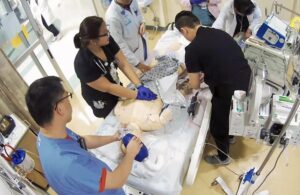
How Managing Clinical Simulation for Competency Can Super-Charge Nursing Education

Avkin’s Avbirth Birthing Simulator Takes EMS Industry by Storm

Bridging the EMS System Trauma Simulation Gap with Culture Over Technology
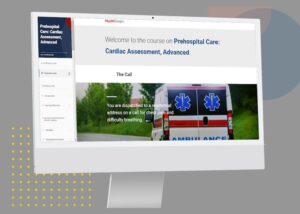
Optimize Competency & Reduce Training Costs with HealthStream’s EMS Program

EMS Competency Solution to Meet Nursing Education Competencies Needs

EMS Supercharge Your Sim with Centralized Operations, Increased Flexibility, and Actionable Data
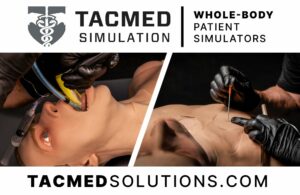
Elevate Your Simulated EMS Training with Tactical Medical Solutions

Watch All #IMSH2023 Healthcare Simulation Industry Press Box Interviews
Subscribe to HealthySimulation.com For All the Latest EMS Simulator Updates!
Sponsored Content:




